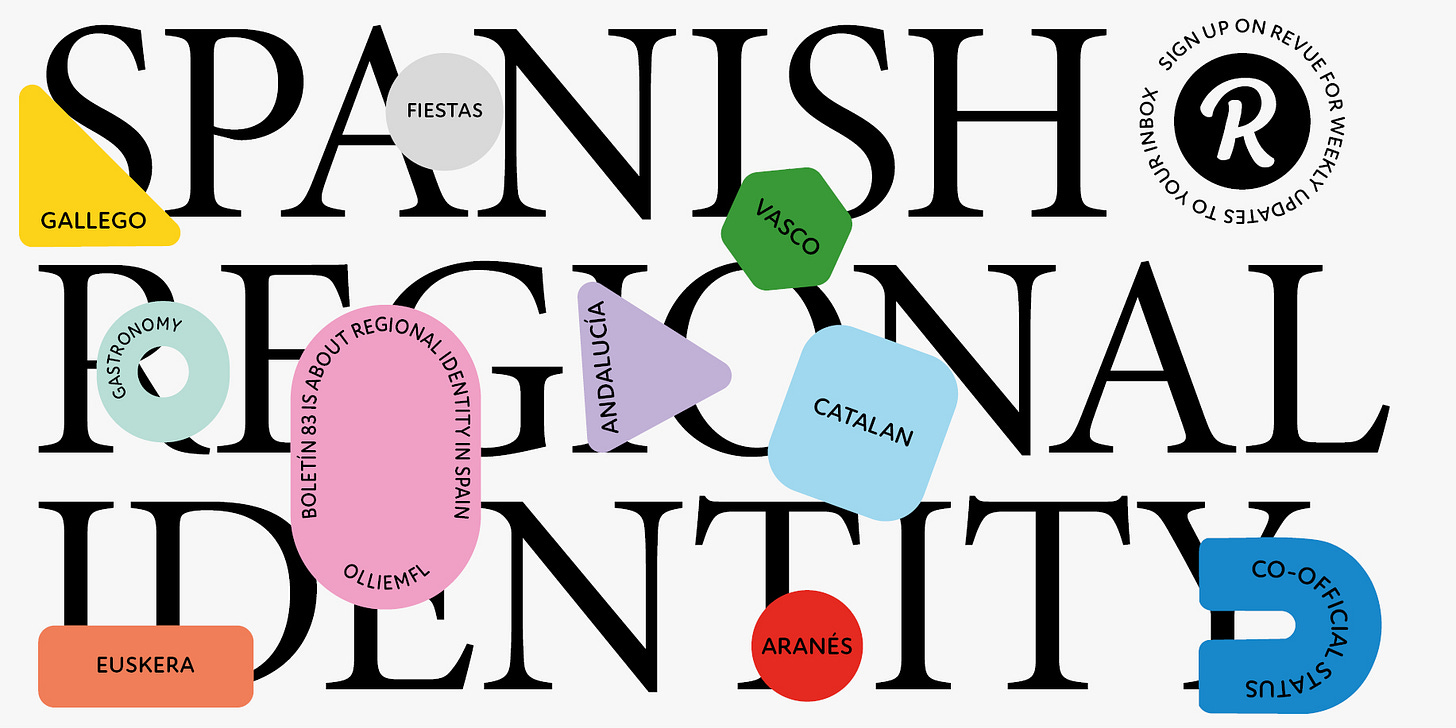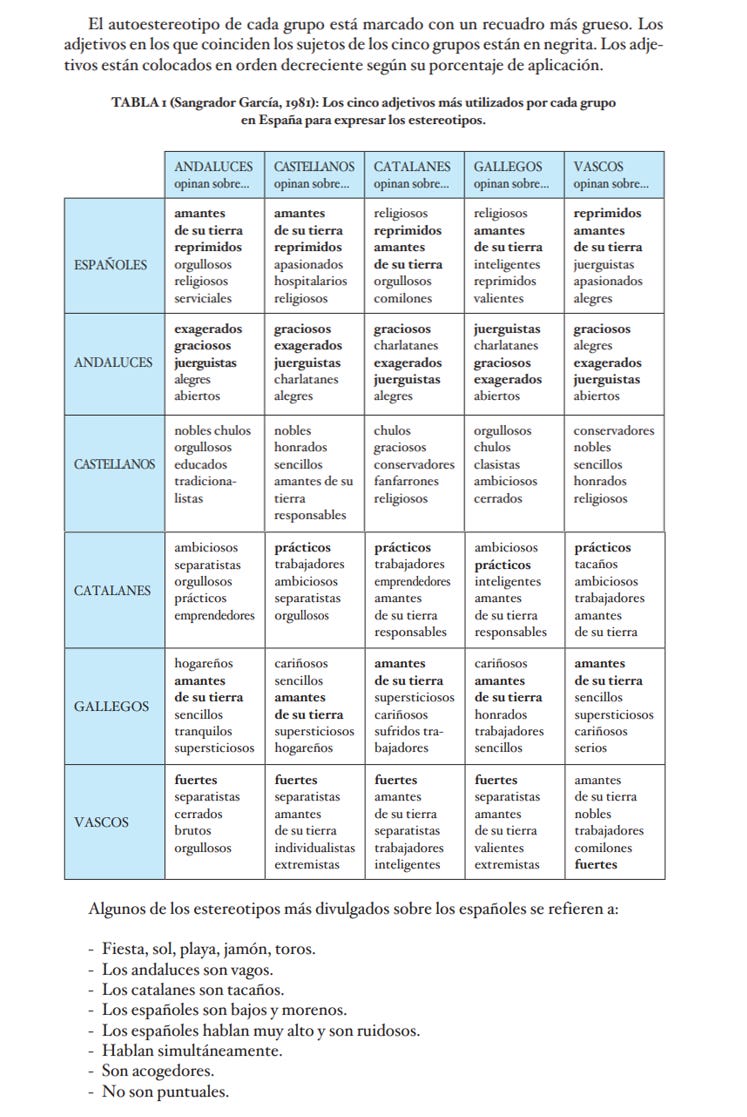Boletín 108 - Los valores tradicionales, las comunidades autónomas y la identidad cultural.
Last week ChatGPT made a movie script for me set in the oldest restaurant in Madrid. The cast were my year 12s. The scene revolved around asking a friendly waiter about some typical dishes and after paying the cast discussed whether Spanish traditional cuisine is under threat.
Hola de nuevo/kaixo berriro/hola de nou/ola de novo.
In this week’s newsletter:
An update.
Edition 108 of Boletín (the three texts).
Tier 2/3 vocabulary and grammar search for students.
Edition 83 throwback/regional stereotypes.
Download link and student friendly newsletter printout.
An update.
🤩Boletín now has a shiny new domain name! (www.boletin.co.uk).
👨🏻💻 No more hiding behind an avatar. I’ve updated the about page which now includes an actual photo of me and bit of a bio.
Edition 108.
I really struggled putting together this edition of Boletín. I was set on two of the texts a week ago and settled on the third today (18/03). The most difficult thing was the accompanying graphic. This is the bit I usually love the most but I just couldn’t think of anything great so have settled for some (I hope) impactful text.
For my subscribers who do not download the student worksheet the texts this week are below:
Los valores tradicionales1
Una encuesta ha revelado que España es uno de los cuatro países que menos interés tienen por un retorno a los valores tradicionales y que también considera que no estaríamos mejor si volviéramos a vivir según ideas, normas o costumbres del pasado. Los valores tradicionales varian dependiendo de la región pero algunos valores comunes incluyen: la importancia de la familia, el respeto por la autoridad, la religiosidad, las buenas maneras, la etiqueta y el valor del ocio. En la mayoría de los países, a diferencia de España, la región capitalina muestra un menor interés por los valores tradicionales.
Los comunidades autónomas2
Conocer nuestras comunidades autónomas es descubrir la gran riqueza cultural y natural que tiene España. Existen un total de 17 comunidades autónomas y dos ciudades autónomas: Ceuta y Melilla. Cada una de ellas cuenta con rasgos propios y característicos que podrás apreciar, por ejemplo, en sus monumentos y ciudades, durante sus fiestas y tradiciones, o su gastronomía típica. Los contrastes en sus paisajes también llamarán tu atención. Podrás pasear por un bosque o perderte por un desierto. Disfrutar de playas admirables en sus fascinantes costas o conocer pequeñas calas en cualquiera de sus islas.
La identidad cultural3
La identidad cultural es el conjunto de valores, tradiciones, símbolos, creencias y modos de comportamiento que funcionan como elementos dentro de un grupo social. En un mundo cada vez más globalizado donde internet y la forma de interactuar a través de las redes sociales han permitido conocer nuevas culturas, es de vital importancia no dejar de lado nuestra verdadera esencia, nuestro sentido de ser, nuestro origen, nuestra historia, nuestro sentido de pertenencia y con ello nuestros valores y trabajar para mantener la esencia de fiestas y actividades culturales como identidad local del municipio.
Tier 2/3 vocabulary.
Una encuesta - a survey
El ocio - leisure
La riqueza - richness
Un rasgo - a trait
Una cala - cove/small bay
Una creencia - a belief
Grammar to look out for.
The present perfect tense.
Simple connectives.
The imperfect subjunctive.
The present tense.
Definite articles.
The future tense (regulars and irregulars).
Cada vez más/menos + adjective - more and more/less and less
ChatGPT created a script for me and it’s awesome!
Okay, so I know everybody is fed up with ChatGPT (spoiler: it’s about to get worse with GPT4). I am too. Especially when it comes to viral marketers selling webinars, hastily put together books and posting Twitter threads along the lines of “ChatGPT is the fastest website to gain 1 billion users but 99% don’t know how to use it properly”.
But indulge me for 2 minutes. I had been harbouring an idea…
What if, with the help of ChatGPT, I created a movie script based in a Spanish city in which the main cast was made up of my year 12 class?
What if the script was completely tailored to my class with all their idiosyncrasies and developed as we worked our way through the course. A new scene every half-term.
What if I asked ChatGPT to write it at any CEFR level I wished depending on the desired level of difficulty?
What if I asked ChatGPT to include very specific words from a vocabulary list based on the topics we study in year 12?
What if I asked it to also include a specific grammatical structure?
What if I asked ChatGPT to include minor characters like waiters and the like with whom my main cast could interact with?
The result.
Before you read a couple of example scenes from the script as well as the ChatGPT prompt, the deal may have been sweetened by a Spanish Lidl week haul but an AS speaking lesson went really well last week. In between mouthfuls of tortilla and lots of laughter we read the script together first playing ourselves and then switching roles so the class had the chance to read other people’s lines. We then transitioned into a set a/b speaking task on regional gastronomy.
Spoiler alert for my year 12s: I’ll be doing a similar thing next week for sure!
👇Now before you get to the script, a strategically placed button! 👇
Okay the prompt…
We are currently studying regional identity and the sub-topic of food. I’ve changed the characters names to generic ones so you can use the script in your class.
My prompt to ChatGPT (which you, yes you, should copy, changing the names of the characters and adding a few humorous interactions you want to take place and idiosyncrasies) was:
Write, in Spanish CEFR level B1, a scene from a film script set in Madrid in the style of Pedro Almodóvar. Four young people (Student 1, Student 2, Student 3, and Student 4) arrive at the restaurant Casa Botín. They discuss Spanish food and what to order asking the waiter for information about the dishes on the menu. The dishes are: la tortilla de patatas, la paella, los huevos rotos, las patatas bravas, las croquetas y los callos a lo madrileña. The script must include the following vocabulary: me gustaría probar, la región, los mariscos, rico, típico, la calidad, la merienda, el sabor. Student 3 tries to talk about football but is ignored by the group.
Write, in Spanish CEFR level B1, a scene from a film script set in Madrid in the style of Pedro Almodóvar. Four young people (Student 1, Student 2, Student 3, and Student 4) have just paid the bill at Casa Botín and are walking home. They discuss the rich variety of Spanish food and whether it is under threat from the increasing influence of fast food and ready meals. Student 3 tries to start a conversation about Arsenal football club but Student 1 shuts him down.
After putting the resulting text into a film script formatter the result is the PDF below. If you use it in class I’d love to know how it goes and how you think it could develop! Imagine a script which followed the whole curriculum featuring your students and the vocabulary/grammar you teach!
Edition 83 throwback.
Just a little reminder that if you, like me, are currently teaching/learning about regional identity then go and read edition 83! Other similar themed editions are:
Boletín 37 - Regional languages
Boletín 43 - Gastronomíá
Boletín 50 - Festivales
Regional stereotypes
Ocho Apellidos Vascos is on the AQA specification so I feel less bad about sharing below the stereotype map of Spain (made by Buzzfeed I hasten to add). Although a lot of the references on the map go straight over my head I use it in conjunction with a really interesting adjective table (below) from the book Estereotipos de las nacionalidades y regiones de España to introduce Spain in a more light-hearted way.
Download the student friendly newsletter printout.
Download edition 108 here.
Ollie
❤️
From spain.info.
From almanatura.com.






